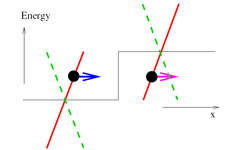How massless electrons tunnel through graphene (Vol. 43 No. 2)
 Klein tunnelling in one dimension. An electron incident from the left on a sharp potential step (the blue arrow indicates its direction of motion)
Klein tunnelling in one dimension. An electron incident from the left on a sharp potential step (the blue arrow indicates its direction of motion)
Electrons moving in graphene behave in an unusual way, as demonstrated by 2010 Nobel Prize laureates for physics A. Geim and K. Novoselov, who performed transport experiments on this one-carbon-atom-thick material. The present review explores the theoretical and experimental results to date of electrons tunnelling through energy barriers in graphene.
What could partly explain graphene's properties is that electrons travelling inside the material behave as if they were massless. Their behaviour is described by the so-called Dirac equation, which is normally used for high-energy particles such as neutrinos in vacuum moving at a velocity 300 times greater than that of electrons, nearing the speed of light.
In this review, the authors focus on the tunnelling effect occurring when Dirac electrons found in graphene are transmitted through different types of energy barriers. Contrary to the laws of classical mechanics, which govern larger scale particles that cannot cross energy barriers, electron tunnelling is possible in quantum mechanics - though only under restricted conditions, depending on the width and energy height of the barrier.
However, the Dirac electrons found in graphene can tunnel through energy barriers regardless of their width and energy height; a phenomenon called Klein tunnelling, described theoretically for 3D massive Dirac electrons by the Swedish physicist Oskar Klein in 1929. Graphene was the first material in which Klein tunnelling was observed experimentally, as massive Dirac electrons required energy barriers too large to be observed.
Klein tunnelling in graphene: optics with massless electrons
P.E. Allain and J.N. Fuchs, Eur. Phys. J. B 83, 301 (2011)
[Abstract]





